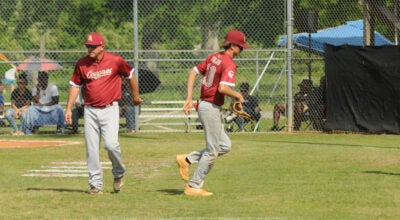Swimming 101
Published 12:24 pm Saturday, June 12, 2010
During summer, swimming is a part of everyday life for people all over the area.
Children visit swimming pools, families take trips to the ocean, lake or river and most everyone gets in the water.
With such high numbers of people making trips to their favorite watering hole, it is crucial for children and adults to know how to enjoy this time safely.
The Tom Byrne Park pool offers swim lessons to all ages and teaches those interested in learning how to swim all of the basic techniques needed for swimming.
Betty Warren, manager of the Tom Byrne Park pool, said that having children take swim lessons is always vital.
“It can be the difference between life and death,” Warren said. “It’s like CPR. Our ability to offer swim lessons at such a low cost is wonderful and important because we are so close to the water.”
With the swim lessons, students learn several skills that will help them have a safer, more fun experience in the water.
Warren said the classes at the pool do a good job of teaching even the smallest children important techniques.
“We go over safety skills and how to respect the water,” Warren said. “You’d be surprised at how much the little ones will remember. We have parents come and tell us how their child came home and explained the techniques they learned in their swim lesson.”
The first thing swimmer’s must learn to do is respect the water and the environment around them.
Sarah Ziglar, a swim lesson instructor at the pool, said it is important for swimmers to respect the water because one wrong move could cause them to go under.
“Respecting the water is crucial because you are affecting not only your environment, but other swimmers as well,” Ziglar said. “For example, when someone is splashing then you might lose sight of a child and not see them go under, and they could drown.”
At the swim lessons, swimmers begin with the basics and work their way up once they have the first step perfect.
Ziglar said the first thing a swimmer learns how to do is go beneath the surface.
“First, we teach them to go under the water,” Ziglar said. “If they can’t go under the water at first, we teach them to blow bubbles, so they can eventually be comfortable with going under the water. After they learn to go under, we teach them the glide. A glide is where they stretch their body out and push off the wall and glide through the water. They have to have the glide perfect before we move on. For children who are unable to glide we teach them how to float on their back.”
Going below the surface, gliding and floating are just the beginning for swim students at the Tom Byrne Park pool.
Once they have fully learned those steps, they are able to move on to learning swimming strokes.
Ziglar said the first step to swimming strokes is learning how to freestyle swim.
“Once they learn the beginning steps, we move them to freestyle and freestyle with breathing,” Ziglar said. “In freestyle they swim and basically move their arms like they are pedaling a bike. After freestyle, we move them to freestyle with breathing, which is when they turn their heads to breathe while swimming. This is used if you want to swim farther distances or the length of the pool.”
The next step in becoming a better swimmer takes the students back to floating on their back.
For swimmers, learning to float on their back is the first step to learning the backstroke.
Ziglar said swimmers learn to float and then kick, while they float on their backs followed by learning the backstroke.
“The first step is to take them back to floating on their back,” Ziglar said. “Once they get used to floating on their back, we teach them how to kick while floating on their back, which is the first step towards learning the back stroke. Once they are able to keep themselves up, then we teach them the back stroke. We follow that up with the elementary backstroke, which kind of looks like a frog when its done.”
Once the backstroke has been learned, students at swim lessons are able to move into other aspects of swimming.
Ziglar said diving and fun tricks come once the student is able to swim.
“Once they have all of that down, we can move them on to diving and proper strokes of diving,” Ziglar said. “Then we can teach them tricks and fun things to do.”
Swimming lessons
• Swim lessons cost $35.
• Monday- Friday from 9 a.m. until noon (1-hour sessions)
• Tuesday & Thursday from 5:20 p.m. until 6:50 p.m. (Thirty-minute sessions).
Swim lesson registration
• June 21-until classes full from 5 p.m. until 6 p.m. (Classes begin June 28)
• July 12-until classes full from 5 p.m. until 6 p.m. (Classes begin July 19).

Tom Byrne Park pool lifeguard Sheena-Marie Currie shows Riley Bagget a floatin exercise during swim lessons Wednesday morning. | Photo by Chandler Myers





